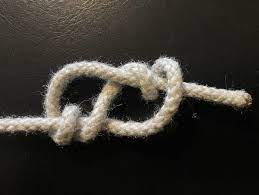Originating from the seafaring era, the pitchfork knot is a remarkably versatile yet deceptively simple knot. Because of its unmatched capacity to secure lines and rigging while enabling simple adjustment and release, sailors and maritime workers heavily depended on this knot. Its practical applications quickly extended beyond the maritime domain to include a wide range of outdoor activities and survival scenarios.
Its versatility and adaptability made it an indispensable piece of gear for them, allowing them to secure their belongings, build temporary shelters, and even devise rescue methods in difficult circumstances.
Real-World Uses for the Pitchfork Knot
- The uses for the pitchfork knot go far beyond its modest origins. It is a dependable tool for setting up carry systems, securing tent lines, and organizing gear in camping and hiking situations. For these kinds of uses, its capacity to tighten firmly while still allowing for adjustments makes it perfect.
- Even in survival and rescue situations, the pitchfork knot has proven to be extremely helpful. It is the preferred material for making makeshift splints or stretchers in an emergency, as well as for making makeshift harnesses and rappelling lines because of its strength and simplicity in untying.
- Pitchfork knots can be used in decorative and artistic projects in addition to their practical uses. Macramé artists and knot enthusiasts have shown this knot’s aesthetic appeal and versatility by incorporating variations into their intricate designs.
Why Learn the Pitchfork Knot?
You might be asking yourself why learning how to tie a Pitchfork knot properly is worthwhile. The benefits and practical applications it provides hold the key to the answer:
- Versatility: Suitable for various applications, from securing loads to emergency rescues.
- Strength: renowned for its capacity to support big weights without slipping.
Materials Required
You will require the proper materials in order to tie a pitchfork knot. This is what you ought to have available:
Choosing the Right Rope
A strong rope is needed to tie pitchfork knots. The strength and durability of nylon and polyester ropes make them great options. For an extended period, these materials guarantee that your knots remain strong and taut.
Equipment You will Need
- Powerful Scissors: Needed to cut the rope to the right length.
- It makes sense to protect your hands by donning gloves, especially when handling thick or heavy rope.
Simple Steps to Follow for Knotting a Pitchfork
- Assemble Your Supplies:
- A few basic knotting supplies, like paracord, carabiners, or other cordage, are required.
- Observe the Guidelines:
- Once you have your supplies and knowledge ready, tie the pitchfork knot according to the comprehensive instructions.
- Making sure the working end is on the right side, start by looping the cord around itself.
- Move the working end through the loop on the right and behind the standing end.
- To make a second loop, pass the working end behind the standing end once more.
- Lastly, thread the working end through the second loop. To gently tighten the knot, pull on both ends.
Typical Errors and How to Prevent Them
Errors happen even to seasoned knotters. The following are typical mistakes to avoid:
- Errors in Loop Formation: Verify that each loop is straight and even.
- Errors in Tying the Knot: Before tightening, make sure the working end has been correctly woven through all of the loops.
Pitchfork Knot Alternatives and Variations
- Although the pitchfork knot is an extremely flexible and strong knot, it is not the only one. Investigating related knot kinds and their advantages can increase one’s skill level in knotting and offer substitutes for certain scenarios.
- For example, the constrictor knot is similar to the pitchfork knot but has even more cinching power, which makes it perfect for compress bandages or securing large loads. In contrast, when slippage is a concern, the adjustable grip hitch provides a more dependable and safe option.
- Additionally, various cultures and traditions have distinct ways of tying knots, each with a long history and useful applications. A deeper appreciation for the creativity and resourcefulness of people worldwide is fostered by adopting these various knotting traditions, which also broaden one’s knowledge.
FAQs
- What is the main objective of Pitchfork Knot?
- It is widely used for load securing and rescue operations due to its dependability.
- Can any kind of rope be tied for the Pitchfork Knot?
- Use of polyester or nylon ropes is recommended due to their robustness and longevity.
- In what way can I tell if the knot is tied correctly?
- There should be no tension in any of the loops, and the knot should be balanced.
- Does using the Pitchfork Knot make sense when climbing?
- Indeed, it is commonly used in climbing because it can support heavy loads securely.
- How can I become a better knotter?
- Try different types of ropes, practice frequently, and focus on the specifics of each step.
Conclusion
Learning how to tie a pitchfork knot can lead to a multitude of opportunities, including outdoor experiences and crisis situations. It is an invaluable skill that anyone can possess due to its unmatched strength and dependability. You will be tying the Pitchfork Knot like a pro in no time at all if you grab some rope and practice!
